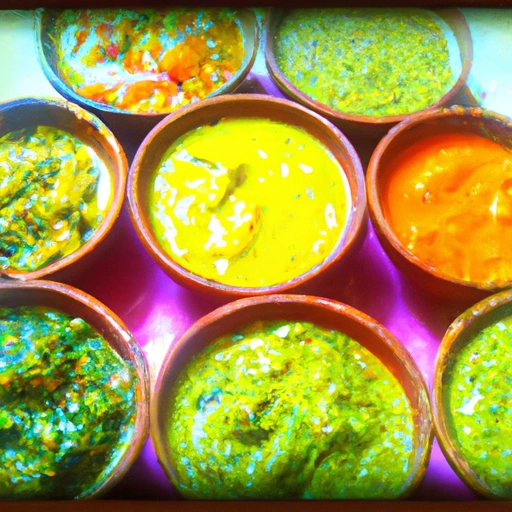Chutney
Description

Chutney is a vibrant and diverse condiment that often takes the form of a thick sauce or relish. Made from a mixture of fruits, vegetables, herbs, spices, sugar, and vinegar, it adds a burst of flavor to a multitude of dishes. Ranging from sweet to savory, tangy to spicy, chutneys can come in various textures and consistencies, from chunky to smooth. They are used in cuisines around the world, reflecting local ingredients and cultural preferences, and are measured in a variety of units, including teaspoons (tsp), tablespoons (tbsp), fluid ounces (fl oz), grams (g), and milliliters (mL).
Common uses
Chutneys are incredibly versatile and can be used as a dip, spread, glaze, or accompaniment. They are commonly served with appetizers, such as samosas and pakoras, and can be paired with cheeses, meats, or sandwiches to enhance their flavors. In some regions, chutney is used to add zest to rice dishes or as a base for marinades and dressings.
Nutritional value
Calories
The caloric content of chutney can vary widely based on its ingredients. On average, a tablespoon (about 15 mL) of chutney may contain approximately 20 to 50 calories.
Protein
Chutney is typically low in protein, offering less than 1 gram per serving.
Fat
Most chutneys are low in fat, with negligible amounts per serving, unless nuts or seeds are included in the recipe.
Carbohydrates
Carbohydrate content in chutney largely comes from the natural sugars in fruits and any added sweeteners, with an average of 5 to 10 grams per tablespoon.
Vitamins
The fruit and vegetable components of chutney may provide vitamins such as vitamin C, vitamin A, and some B vitamins, though the amounts can be minimal per serving.
Minerals
Depending on the ingredients, chutneys may contain trace minerals like potassium, magnesium, and iron.
Health benefits
While chutneys are consumed in small quantities, they can contribute to a balanced diet with their inclusion of fruits and vegetables. The spices commonly used, such as ginger, garlic, and turmeric, have anti-inflammatory and antibacterial properties. Vinegar, a key ingredient in many chutneys, may help with blood sugar control. However, the health benefits can be offset by high sugar and sodium levels in some recipes.
Potential risks
Commercially prepared chutneys may contain high levels of sugar, sodium, and preservatives, which could contribute to health issues if consumed in large quantities. Homemade chutney recipes can be modified for lower sugar and salt content. As with any food, there is a risk of foodborne illness if not prepared and stored properly.
Common recipes
Chutneys are often found in Indian cuisine, accompanying dishes like curries, dal, and naan. They are also a staple in British ploughman's lunches and can be found in American cuisine as a condiment for grilled meats and sandwiches.
Cooking methods
Chutneys can be made through slow cooking ingredients until they reach the desired consistency or by blending for a smoother texture. Preservation methods like canning allow them to be stored and enjoyed over time.
Pairing with other ingredients
Chutney pairs well with a variety of foods, including cheese, chicken, pork, and bread. Its flavor profile can be matched with similar spices in dishes or used to create a contrast, adding depth and complexity to a meal.
Summary
Chutney is a dynamic and adaptable condiment with roots in Indian cuisine that has found its way into kitchens worldwide. Its mix of fruit, vegetables, spices, sugar, and vinegar can liven up any dish, offering a range of flavors from sweet and tangy to spicy and savory. While it can be enjoyed for its taste, moderation is key due to its sugar and salt content. When used thoughtfully, chutney can be a delightful addition to a well-rounded culinary repertoire.